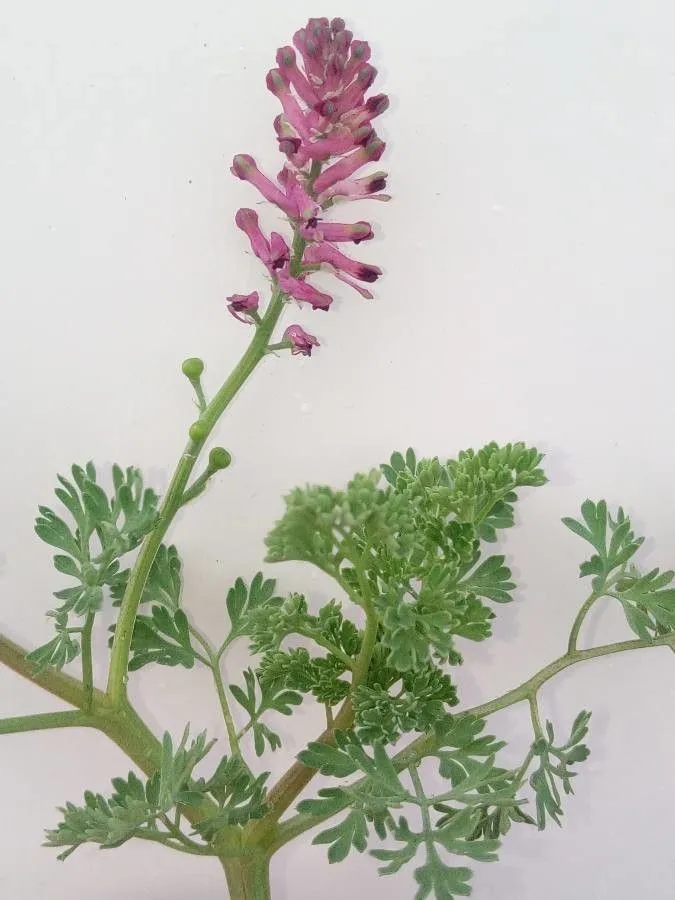
Author: DC.
Bibliography: Cat. pl. horti monsp. 113. 1813
Year: 1813
Status: accepted
Rank: species
Genus: Fumaria
Vegetable: False
Observations: W. Europe, Medit. to Iran
Narrow-leaf fumitory, known scientifically as Fumaria densiflora, is a distinctive species belonging to the Papaveraceae family. First catalogued by the botanist DC. in 1813 in “Cat. pl. horti monsp. 113,” this plant has intrigued botanists and plant enthusiasts alike due to its unique morphological and ecological attributes.
The native range of the Narrow-leaf fumitory extends through Western Europe, covering significant portions of the Mediterranean region, and reaching as far as Iran. This widespread geographical distribution underscores the plant’s adaptability to various climatic and soil conditions, although it typically favors temperate regions.
Characterized by its finely divided, almost feathery leaves, Fumaria densiflora presents a delicate yet complex foliage which contributes to its common name. The slender leaves provide a graceful backdrop to the plant’s small, tubular flowers that generally manifest in shades of pink or purplish hues—blooms that are tightly packed, often giving a dense floral appearance that earns the plant part of its scientific name, ‘densiflora.’
Ecologically, Narrow-leaf fumitory plays a role in natural and semi-natural habitats, where it can often be seen adorning fields, meadows, and sometimes even cultivated lands. It’s a resilient plant, often flourishing in disturbed soils, making it a common sight in areas undergoing ecological succession or those that have experienced some level of human interference.
Despite its presence across various parts of Europe and Asia, Fumaria densiflora maintains a modest profile, often overshadowed by more conspicuous flora. Yet, for those who take the time to observe, the Narrow-leaf fumitory offers a subtle beauty and a notable example of botanical resilience and adaptability.
Eng: dense-flowered fumitory, fumitory, cluster-flower fumitory, dense-flower fumitory, narrow-leaf fumitory
Deu: dichtblütiger erdrauch
Ces: zemedym hustokvety
Nld: dichtbloemige duivenkervel
Swe: tätblommig jordrök
Cym: mwg y ddaear trwchflodeuog, mwg-y-ddaear dwysflodeuog
En: Narrow-leaf fumitory, Dense-flower fumitory, Cluster-flower fumitory, Dense-flowered Fumitory, Fumitory, Dense flowered Fumitory
Ar: زيته، زيتى
Ca: Fumària densiflora
Cs: Zemedym hustokvety
Nl: Dichtbloemige duivenkervel, Dichtbloemige Duivekervel
Fr: Fumeterre à fleurs serrées
De: Dichtblütiger Erdrauch
He: עשנן צפוף
It: Fumaria densiflora
Es: Palomilla romana
Sv: Tätblommig jordrök
Cy: Mwg y Ddaear Trwchflodeuog, Mwg-y-Ddaear Dwysflodeuog
Taken Mar 12, 2020 by Eva Sanjuán (cc-by-sa)
Taken Apr 14, 2016 by Tela Botanica − Liliane ROUBAUDI (cc-by-sa)
Taken Apr 14, 2016 by Tela Botanica − Liliane ROUBAUDI (cc-by-sa)
Taken Mar 7, 2022 by Rafael Rodriguez Navas (cc-by-sa)
Taken Mar 4, 2020 by j B (cc-by-sa)
Taken Apr 15, 2020 by Ondřej Jokerrr83 (cc-by-sa)
Taken Feb 28, 2022 by Fred (cc-by-sa)
Taken Feb 18, 2015 by Tela Botanica − Gregoire Pernot du breuil (cc-by-sa)
Taken Apr 14, 2016 by Tela Botanica − Liliane ROUBAUDI (cc-by-sa)
Taken Mar 4, 2020 by j B (cc-by-sa)
Taken Mar 8, 2017 by Pep Secem (cc-by-sa)
Taken Mar 26, 2022 by Rafael Sanchez (cc-by-sa)
Taken Mar 4, 2020 by j B (cc-by-sa)
Taken Jan 30, 2020 by Bj Dady (cc-by-sa)
Taken Mar 8, 2017 by Pep Secem (cc-by-sa)
Taken Apr 21, 2021 by Laura GUILLAIN (cc-by-sa)
Taken Apr 14, 2016 by Tela Botanica − Liliane ROUBAUDI (cc-by-sa)
Taken Apr 14, 2016 by Tela Botanica − Liliane ROUBAUDI (cc-by-sa)
Taken Apr 14, 2016 by Tela Botanica − Liliane ROUBAUDI (cc-by-sa)
Taken Apr 14, 2016 by Tela Botanica − Liliane ROUBAUDI (cc-by-sa)
Taken Apr 18, 2021 by Óscar Mencía (cc-by-sa)
Taken Feb 2, 2021 by ubaldo pioggiasole (cc-by-sa)
Taken Feb 9, 2022 by -Minute man- (cc-by-sa)
Taken Jan 1, 1970 by Photoflora – L’Abbé COSTE (©)
Taken May 15, 2003 by Photoflora – Jean-Luc TASSET (©)
Taken Jun 10, 1883 by Tela Botanica − Herbier PONTARLIER-MARICHAL (cc-by-sa)
© copyright of the Board of Trustees of the Royal Botanic Gardens, Kew.
© copyright of the Board of Trustees of the Royal Botanic Gardens, Kew.
© copyright of the Board of Trustees of the Royal Botanic Gardens, Kew.
Ph maximum: 7.5
Ph minimum: 7.0
Light: 9
Atmospheric humidity: 4
Bloom months: [‘apr’, ‘may’, ‘jun’, ‘jul’]
Soil nutriments: 7
Family: Myrtaceae Author: (F.Muell.) K.D.Hill & L.A.S.Johnson Bibliography: Telopea 6: 402 (1995) Year: 1995 Status:…
Family: Rubiaceae Author: Pierre ex A.Froehner Bibliography: Notizbl. Bot. Gart. Berlin-Dahlem 1: 237 (1897) Year:…
Family: Sapindaceae Author: Koidz. Bibliography: J. Coll. Sci. Imp. Univ. Tokyo 32(1): 38 (1911) Year:…
Family: Asteraceae Author: A.Gray Bibliography: Pacif. Railr. Rep.: 107 (1857) Year: 1857 Status: accepted Rank:…
Family: Fabaceae Author: Medik. Bibliography: Vorles. Churpfälz. Phys.-Ökon. Ges. 2: 398 (1787) Year: 1787 Status:…
Family: Aspleniaceae Author: (Cav.) Alston Bibliography: Bull. Misc. Inform. Kew 1932: 309 (1932) Year: 1932…